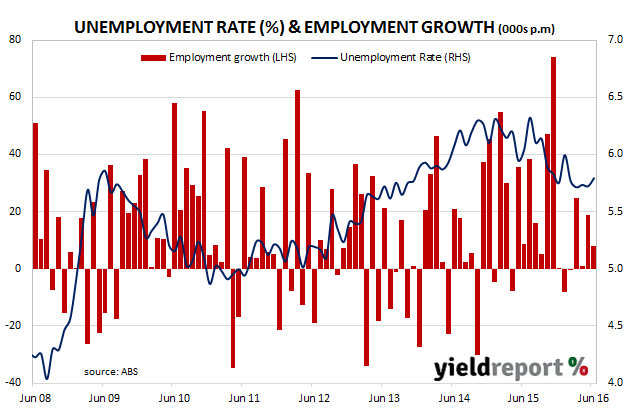Australia’s employment market continued to expand for the fourth month in a row. The ABS released June employment estimates which indicated the total number of people employed in Australia in either full-time or part-time work increased by 7900 during the month. Even so, the unemployment rate increased from 5.7% to 5.8% as more people looked for work. The participation rate rose from 64.8% to 64.9%. Unlike May’s numbers, full time employment was the driver behind the rise in numbers employed as full-time employment increased by 38,400 while part-time employment fell by 30,600.
The local currency rose 0.30 US cents on the news and then proceeded to move higher for the rest of the day/morning. 3 year and 10 year bonds initially spiked before falling back to end the day 2-3 bps higher at 1.545% and 2.00% respectively.
ANZ said “the labour market remains in ok shape, although the pace of jobs growth has eased and unemployment has ticked higher.” The bank cautioned that employment advertising surveys suggest employment growth is likely to ease further, despite positive business surveys.
The bank still expects the RBA to reduce the official rate in August. Westpac was more positive. Senior economist Andrew Hanlan said, “Our assessment is that the labour market will regain momentum over the second half of this year, consistent with positive fundamentals…. Our jobs index has strengthened over recent months, as private business surveys report actual business conditions are at elevated levels, pointing to the prospect for solid employment gains near-term”

There is still more than a little doubt as to the veracity of the data presented. Commonwealth Bank in its review of the figures said, “We remain sceptical of the quality of the jobs data following revisions to the survey back in 2014.” Other observers commented on the apparent contradiction of a fall in total hours worked in conjunction with a rise in full-time employment at the expense of part time employment. Such a combination is counter-intuitive at first glance although it could be down to part-time employees working fewer hours or it may be the result of sampling errors.

